It was 85 °F in my area today, so of course my husband and I went to one of our favorite outdoor attractions: Clark Botanical Garden. We were well rewarded there with blooming plants and animals busy getting into their spring routine. One of our favorite spots in the Garden is a pond where turtles sunbathe and humans rest on welcoming benches.
As we approached the pond I heard a distinctive bird call. I looked down and saw, quite close to me, a beautiful blackbird. The bird was not distressed by my presence.
Bird Looking Directly at Me
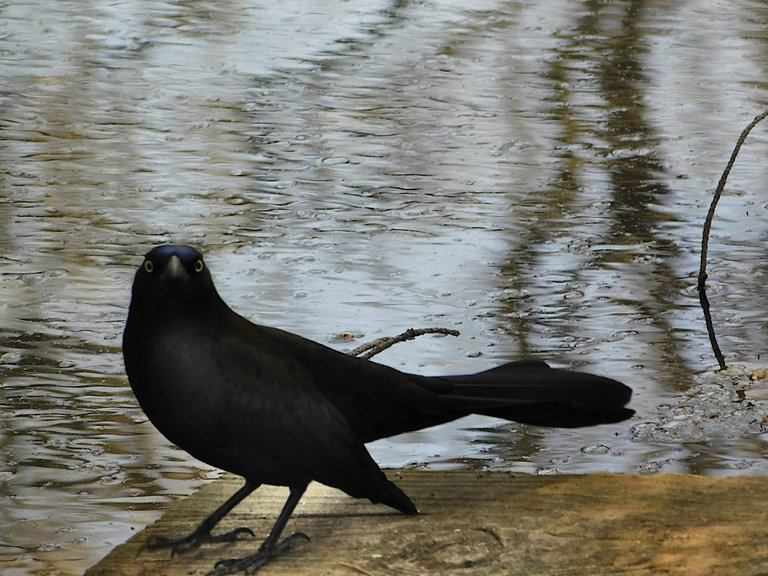
@agmoore
I don't know much about birds, so I couldn't identify this one. I did notice there were others of the same variety in the gardens. I have seen this type of bird before in the community. Later in the afternoon, I looked up descriptions of blackbirds found in the area and decided I had definitely met a grackle that morning.
Common Grackle (Quiscalus-quiscula),
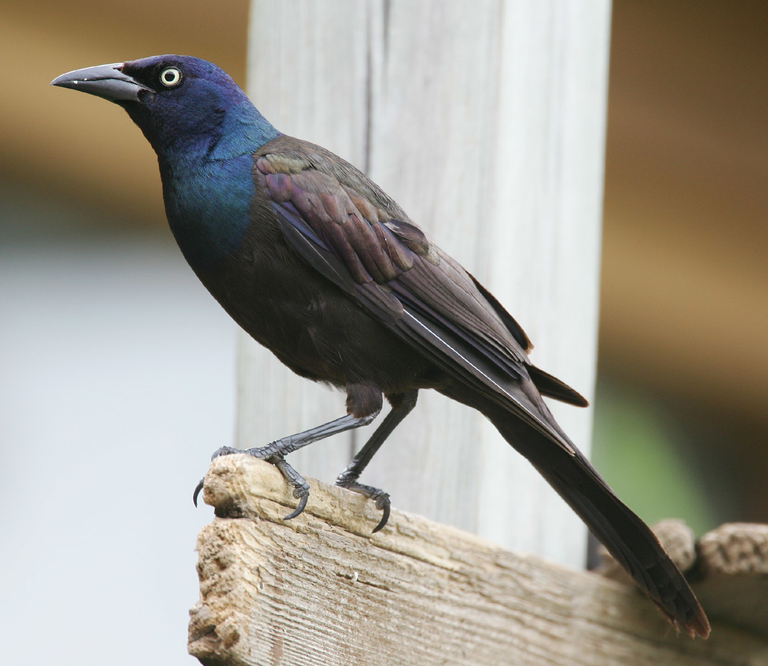
Credit: Mdf. Used under Creative Commons Attribution-Share Alike 3.0 Unported license.
The bird was cawing persistently. The call sounded something like this:
The call was rather persistent. Here is one of the first shots I took of him (yes, it is a him, and I'll explain later). I approached cautiously because I didn't want him to fly away.
But, as you can see from the numerous photos I snapped, he tolerated my approach. Here is one picture where he seems to be listening but not reacting to my presence.
How do I know this bird is a male? According to allaboutbirds.org, the Common grackle is dimorphic, which means males and females can be distinguished by their appearance. Males have glossier, larger bodies and longer tails than females.
Here is a Youtube video of a female and male engaged in a mating dance
And, here is a description: of the Common grackle:
Common Grackles are large, lanky blackbirds with long legs and long tails. The head is flat and the bill is longer than in most blackbirds, with the hint of a downward curve.
The Common grackle has a noticeable bright golden eye. The effect is to give the bird an intent expression. Also, the shape of the grackle's tail is quite distinctive. It is long and 'keel-shaped'. While these birds are known for the iridescence of their feathers (especially the males) they can appear quite black in certain light. Note, for example, the second picture in this blog and the one below this paragraph.
While the Common grackle is a blackbird with an iridescent, almost violet sheen, I saw one that had a bit more blue and wondered if this was usual.
I checked the Internet and found a picture of one that looked almost exactly like the one I spotted (Fourth picture down on the referenced page).
The grackle is, in fact a member of the New World blackbird family (Icteridae). This family includes more than a hundred species and are called New World blackbirds because they are only found in the Americas.
It is believed that the Icteridae evolved in South America and then differentiation occurred across all of the Americas. Grackles and related birds are one of five distinct lineages that evolved from the original Icteridae.
Brown-headed Cowbird (Molothrus)

Credit:Rhododendrites. Used under Creative Commons Attribution-Share Alike 4.0 International license. One of the birds related to the grackle that evolved in the same lineage.
Rear View of Grackle at the Botanical Garden, With Bluer Hue
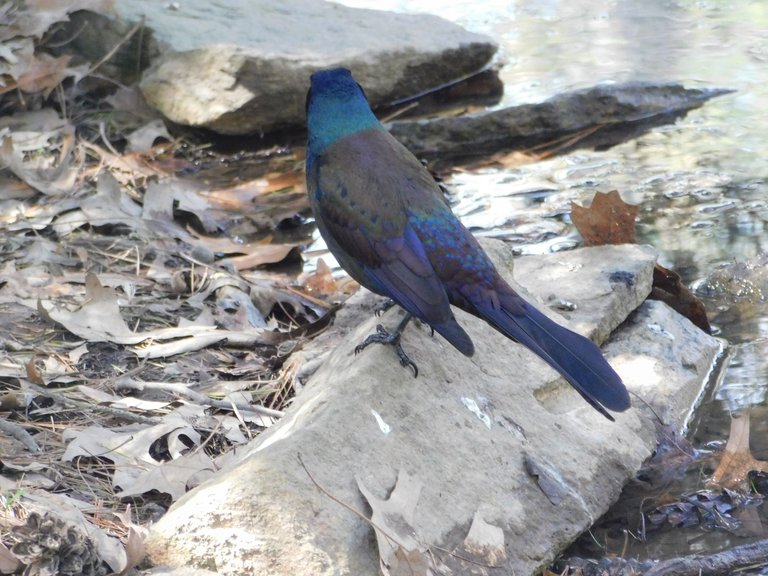
@agmoore
The Common grackle may have a lifespan of approximately 17 years and has been known to live 22 years. This is considered unfortunate by some who view the grackle as a pest. According to the U. S. Department of Agriculture the grackle consumes livestock feed, destroys crops, damages property, spreads pathogens and collides with aircraft. The birds number in the tens of millions.
The Common grackle is often not welcome because of its opportunistic eating habits. In warm weather it may eat crops. In other circumstances it may dominate bird feeders. In the winter it will eat seeds. It also feeds on insects and may steal from other birds' nests.
The Common grackle not only has a long lifespan, but these birds are also successful breeders.
Here is a Youtube video of a mother feeding her nestlings.
I consulted several sites about the Common grackle's mating habits. Most describe the birds as monogamous, mating for life. Some describe them as serially monogamous. Some sites state that the male will occasionally stray and mate with another female.
After mating, the pair will build a nest together and apparently the male remains quite vigilant around the female. It is suggested that this is to make certain another male will not also mate with the female.
Both parents cooperate in the care of the young. There is usually only one brood produced in a year. There may be as few as 2 or as many as 6 eggs in a nest, usually between 4-5. Common grackles generally nest in colonies. Females incubate the eggs but both parents feed the young.
It has been observed that males may assist in feeding the young in other nests. Although one site asserts that half the male grackles abandons the female after she has begun incubating the eggs.
Male Common Grackle at the Botanical Garden
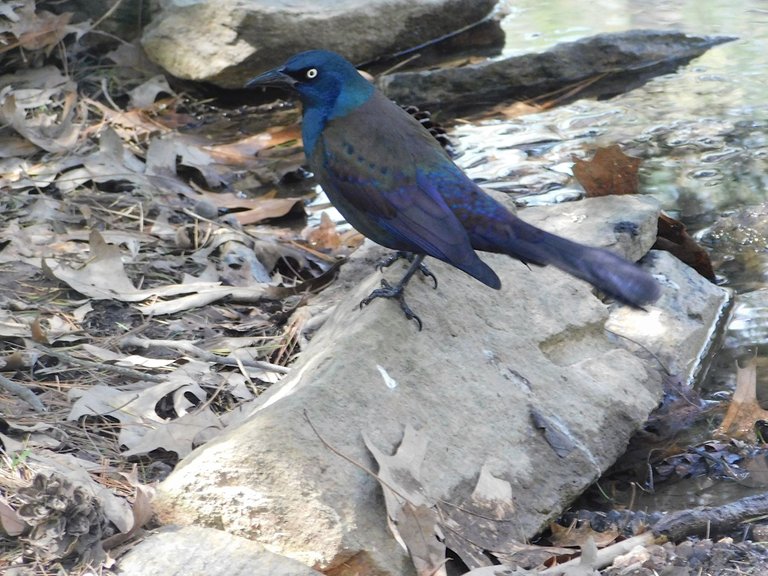
@agmoore
While in this blog I have described and discussed the Common grackle, there are actually three kinds of grackle in North America: Common Grackle, Boat-tailed Grackle and Great-tailed Grackle. The Common Grackle is the most widely dispersed of the three. In all the Americas, there are eleven species with this name (one is extinct).
Boat-tailed Grackle, Florida, USA
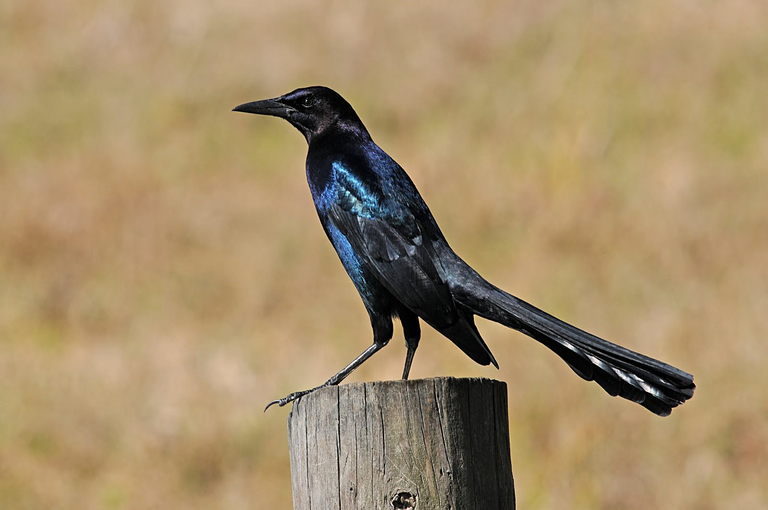
Credit: Connie Denyes, from Picasa Web Albums. Used under CC Attribution 3.0 Unported license
Conclusion
The Common grackle may be a pest to some people, but it is a beautiful bird. I hope you have enjoyed this brief introduction. I certainly enjoyed making this bird's acquaintance.

End Illustration
@yaziris from the LMAC Image Library, LIL (Bird)
@muelli from the LMAC Image Library, LIL (Flowers)
https://www.allaboutbirds.org/guide/Common_Grackle/id
https://abcbirds.org/bird/common-grackle/
https://urbannature.blog/2018/02/01/consider-the-grackle/
https://www.oiseaux-birds.com/page-family-icteridae.html
https://www.labirders.org/webinars/icterids.html
https://www.encyclopedia.com/environment/encyclopedias-almanacs-transcripts-and-maps/new-world-blackbirds-and-orioles-icteridae
https://avitrol.com/pages/bird-facts/grackle/avitrol-grackle-life-span.html
https://www.birdinformer.com/field-guide/common-grackle/
(https://www.birdwatchingdaily.com/beginners/getting-started/coping-with-grackles/
https://www.aviaway.com/grackle
https://animalia.bio/common-grackle
https://animaldiversity.org/accounts/Quiscalus_quiscula/
https://www.audubon.org/field-guide/bird/common-grackle
https://www.birds-of-north-america.net/grackles.html
https://en.wikipedia.org/wiki/Grackle
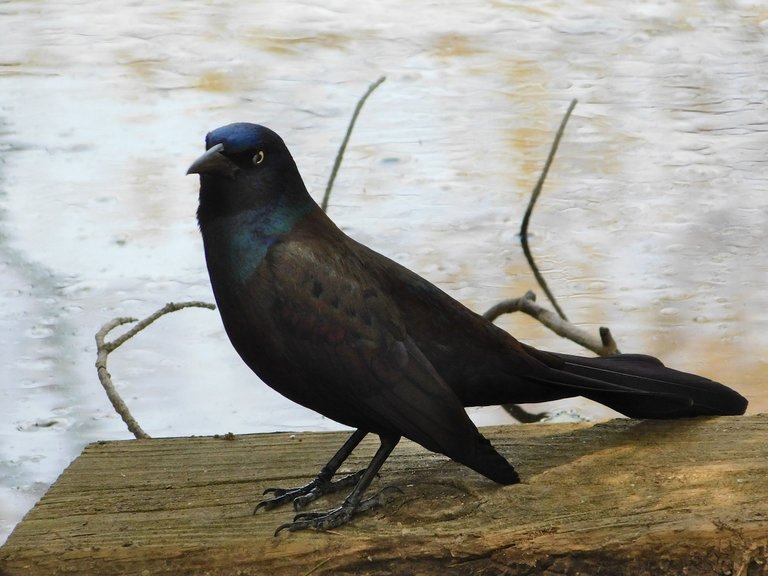
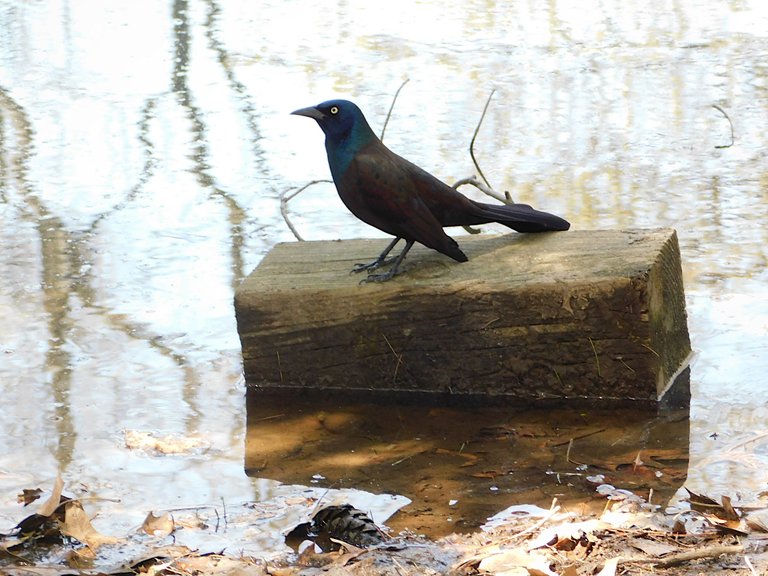
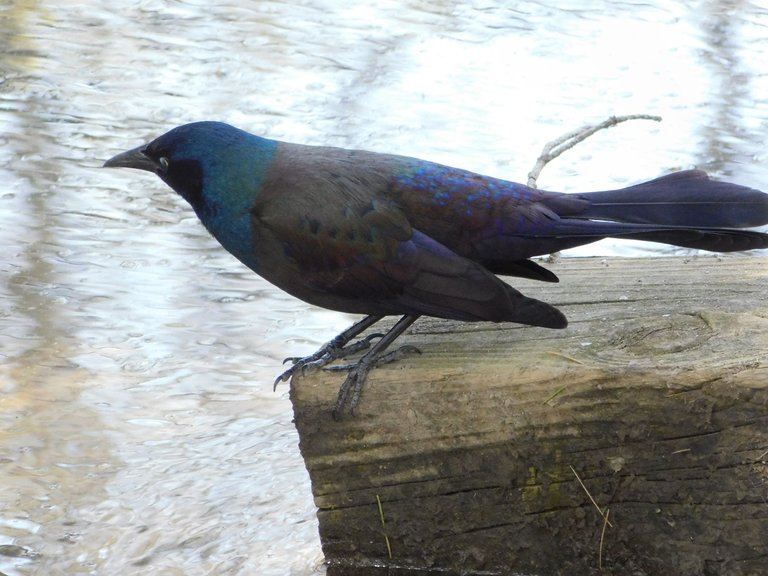
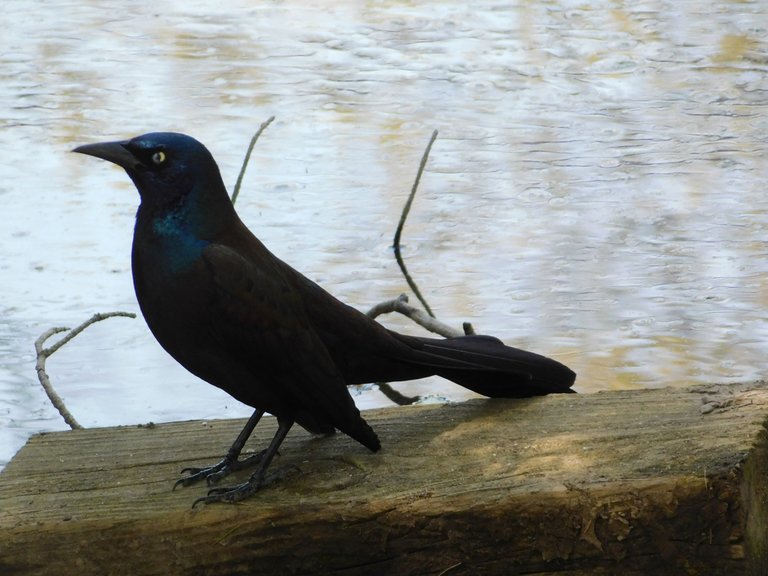
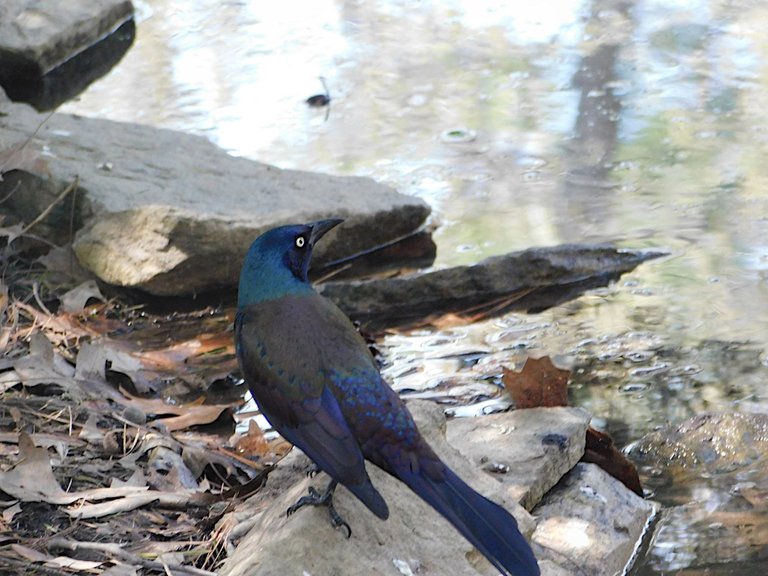
Cute fella 🥰😍
Thank you🐦! Yes he is🌷🕊🦅
Wonderful pictures and a wonderful blog, as always! Thanks!
Thank you for your support and encouragement, @one-eye
Hello @agmoore,
It is been quite a while, how are you and how is the family? So i was going through the community as usual and i saw this and i was like, hei that's agmoore right there, it must be a fun reading because he never disappoints and true to my thoughts i am here learning about the grackle bird that i never knew about and i had fun getting to know the various species and you pleasant encounter too.
It is always a pleasure, thanks for sharing this and i wish you the very best, cheers!!!
Hello @nattybongo,
So nice to see you here. I'm glad you enjoyed this post. I love animals so much that my favorite posts seem to be about them. It never feels like work when I'm learning and writing about animals.
By the way--I finally got a new pair of glasses and an eye exam😆.
Thanks so much for visiting and commenting.
Yeee I’m excited to hear that, finally haha, please do well to take care of well, I recently made a video about caring for one’s glasses I think you should pass through.
What I’ve come to realized that whenever we do something we are passionate about it hardly ever feels like work and we get to enjoy what we re doing too, I am certain I would be learning about a lot of different species of animals from you moving forward then…
It was a pleasure once again, thank you sir
Lovely shots of the grackles, A.G.@agmoore. There are a couple grackles that make a nest in the emerald cedar trees in my front yard. They come back every spring, have their babies and stay around but only the two adults come back each spring and start the cycle over again. A pretty bird with shiny bluish head feathers and devilish looking yellow eye. 😆. Although they like to rule, my blue jays and doves stand their ground against them when eating the seeds and cat food I throw out for them.
Sounds like you and Hubby are enjoying the nice weather. We are getting there with warmer temps but today looks overcast.
A photo of the grackles from last summer “I’m the boss, look at me!”
The birds are beautiful. I've read they can be bullies, but isn't it great the way they stay together, year after year?
That is a wonderful picture, the two birds together.
Isn't that great. A place for everyone, and everyone in the proper place.Thanks for the visit and wonderful feedback, my friend.
Have a great week, @redheadpei
They look a bit like ravens from certain angles. Related? Definitely beautiful!
Hello @alexanderalexis,
They do look alike but are in different families. The raven is a corvid, which is the crow family and the grackle is an icterid. They are both common in this part of the world.
I hope you are well. Nice to see you here 😇
What a lovely encounter you had! Thank you for the beautiful info, photos and videos!
!LUV
Thank you for the lovely comment, @katerinaramm. I hope you and the kitties are well ♥️
The Common Grackle bird is not seen in our area, it is a strangely beautiful bird. Your objervation helped identify a species of bird
Thank you, @momins. Yes it is a strangely beautiful bird. It was great to find such clear descriptions and pictures on the Internet so that I could identify it.
I appreciate your comment.
I guess the bird that was looking at you directly wanted to pose for the picture.
Hahaha
I had the feeling he was posing :)) A lovely bird.
Thanks for stopping by
Wow. Never heard of a grackle, but love the name - and what beautiful feathers! Thanks for sharing. I don't think we have them here - bloody well have bloody bloody blackbirds though.
New to me also. At first I started calling it a Gracken (confusing it with Cracken maybe 😄). But once you've seen this lovely bird, you will know it.
Thanks for stopping by, @riverflows
Sometimes we don't notice certain birds until we do, if that makes sense. For me it's what I call a spangled pigeon, which is actually a common bronzewing. I have seen them all my life but not REALLY seen them, if that makes sense. Then I started to notice them more as there was a family around here. They sound like a cow blowing into a bottle. I love them.
Now that conjures a memorable experience😆
Beautiful bird!
The bird looks so beautiful and lovely. Thanks for your updates.
Thank you! I really enjoyed learning about this bird and taking those pictures on a lovely, sunny day.
Thanks for your comment, @jude9
Stunning and splendid photos of the shy and clever forager! In my first glance I thought it to be Indian blackbird ( we call it ‘xalika’) but then came to know about its real identity. I actually compared them to the Indian blackbird and found that they are quite larger and have a longer tail. Although Common grackle is nowhere to be found here in my place but my place is full of the Indian blackbird. Thank you for sharing such a beautiful and informative post.
I just looked up the Indian blackbird. It is quite beautiful but, as you say, the grackle is larger. Plus the grackle has black feet. I know very little about birds and am enjoying this little exploration.
Thank you for your kind words and for that introduction to the Indian blackbird.
The bird looks like it's posing for your camera, haha that's a perfect camera shot in my opinion.
Thank you! I noticed the animals in the park do not seem to be as shy as animals on the street. Perhaps they are used to people :)
Yes, because the existence of people beside them is not a threat.
This Bird looks so beautiful and cute. From the way you have seen its pictures it looks very clean and the color on it is also very beautiful and thanks for sharing this great information about this bird.
Thank you! It was a beautiful bird, a beautiful day. We say robins that posed for us. The turtles were having a grand time in the sun also. I appreciate your comment. Have a great Weekend!
Most welcome dear. Have a nice day.
I don't know why, but the term when you say..
Got me in a set of giggles😂😂
As they mate in colonies, I can just imagine a scenario where blackbird female A, looking for her mate and finding him with coming out of the nest or even better in the act of straying with female B😂😂
Female A, confronts the male for his behavior and he replies saying...
Lovely contrast from the ever faithful bluejay😗
😆
Thanks for the comment, and the humor, @seki1
Anytime 😂😂
This post is really informative @agmoore, I think this bird posed perfectly so you could get good photos. On the other hand, I don't know much about birds either, but I think that here in Venezuela there is also a similar species, maybe they are of the same genus, I recognized it not only by the sample you share through the photos, but the video you left on Youtube made me clear my doubts when I heard the song. As a curious fact, here they usually nest in the trees of urban areas, when they already have offspring they pounce on the heads of all those people who pass near their nests, they do not peck but they get tangled in the hair of those who have long hair haha, it's kind of funny because when you hear their songs in an altered way you have to avoid the trees where they are or run. They are very beautiful birds, they are also reminiscent of crows because of their black color, a hug @agmoore.
Oh my heavens. These birds certainly have personality. I'm very glad I took the pictures and read about them. In the future they will be more noticeable on my walks. Maybe they'll pose for me again :)
Thank you very much for reading and for interesting comment. Warm regards, my friend @abneagro.
Lo felicito por usar correctamente la taxonomía binomial. Saludos. aliriera
Gracias, @aliriera. I appreciate that you read my post and offered that interesting comment. Thanks for stopping by.
Thanks for your contribution to the STEMsocial community. Feel free to join us on discord to get to know the rest of us!
Please consider delegating to the @stemsocial account (85% of the curation rewards are returned).
Thanks for including @stemsocial as a beneficiary, which gives you stronger support.
Thank you for the acknowledgement and support, @stemsocial